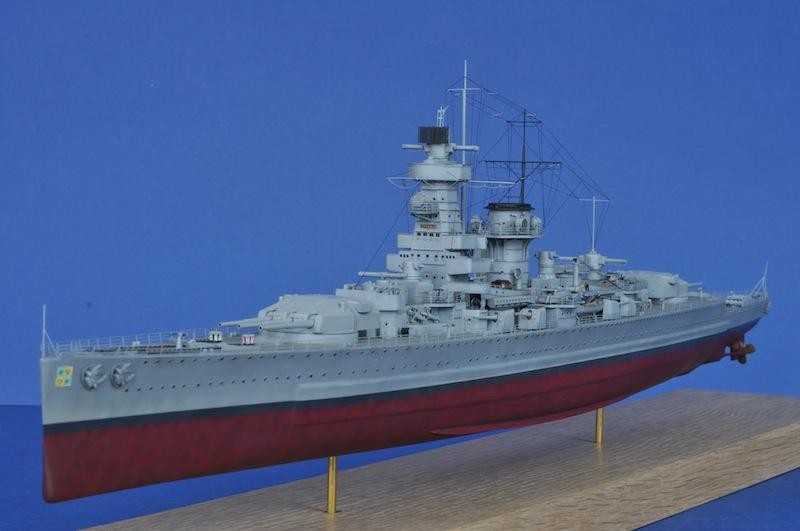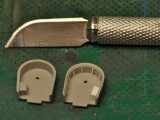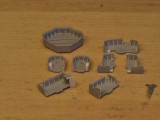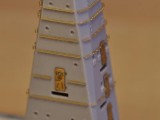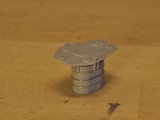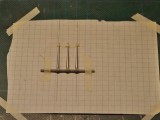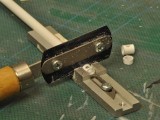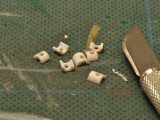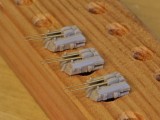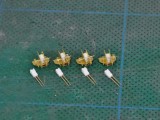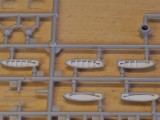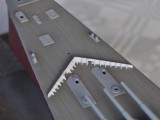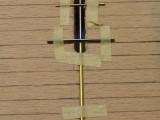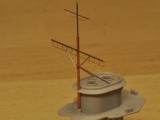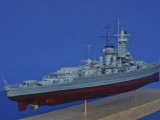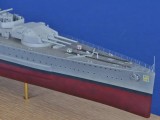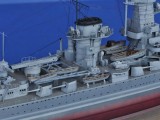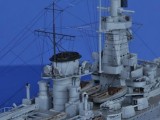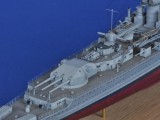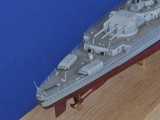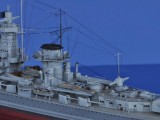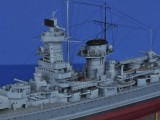TRUMPETER’S GRAF SPEE IN 1:350
Graf Spee was the third and last of the "Deutschland Class" ships. In Germany they were referred to as "Panzerschiffe", which means "armored ships". In other countries they were called "pocket battleships" They were designed to be merchant raiders, to be faster than the stronger enemy ships and to be stronger than the faster enemy ships.
In this aspect their design was very successful. The mighty Royal Navy had only three ships, the HMS Hood, HMS Renown and HMS Repulse, that were both fast enough catch up with them and then strong enough to beat them. The french navy had nothing and built the Dunkerque and the Strassbourg as a response.
Their displacement was officially 10 000 tons in order to comply with the regulations of the Versailles Treaty, but Graf Spees displacement was actually 14 890 tons.
She was launched the 30. June 1934, commissioned the 6. January 1936 and after her trials she took part in the neutrality watch during the spanish civil war.
In August 1939, before the WW2 had started, she and several supply ships, were sent to the South Atlantic to lay in waiting, ready to start commerce raiding.
From the 30 September to the 7 December 1939 the Graf Spee sank nine allied merchant ships. Enormous allied naval forces were deployed to hunt her down and on the 13. December 1939 she was spotted off Montevideo by the british cruisers HMS Ajax and HMS Exeter and the New Zealand cruiser HMNZS Achilles.
In the ensuing battle the HMS Exeter and the HMS Ajax were badly damaged and the HMNZS Achilles was lightly damaged. Graf Spee received light damages and used up most of her ammunition. She sought refuge in the neutral Harbour of Montevideo but was only allowed a 72 hour respite to repair her damages.
Rather than running the gauntlet across the Atlantic with a damaged ship low on ammunition, commodore Langsdorf scuttled his ship just outside the harbour and then committed suicide.
The wreck burned for three days and is still visible at low tide.
The kit is a typical or Trumpeters ship kits. The hull is divided into an upper and a lower part, which caused the usual problems.
The superstructure of the Graf Spee is fairly simple, so dividing it into paintable subassemblies is fairly easy. For the detailing I used PE from White Ensign. Their set is designed for the Hobby Boss kit of Graf Spee, but it works reasonably well for Trumpeters kit as well.
I replaced the kits gun barrels with turned ones from Master Models.
The bulwarks of the the bridge wings and other platforms are way too thick, so I thinned them down and added stanchions from 0,25mm plastic strip.
The fit between the bridge wings and the central turret is not perfect. I filled the gap with 0,25mm plastic strip and then carefully sanded and dryfitted the bridge wings to the central turret.
The next step was to fit handrails and watertight doors to the turret. This was quite easy, since I could use the moulded handrails as guides for the photoetched ones.
I glued them with diluted white glue, since that gives more time for adjustments than superglue.
Fitting the handrails to the funnel was quite another matter. It took lot of trial and error before I found a way to fit the handrails to the curved surfaces of the funnel.
Some words not found in ordinary dictionaries crossed my lips...
The method I settled on, was to trace the shape of the funnel with a pen on a piece of paper and use that as a guide when shaping the handrails.
I can't tell wether it's better to cut the handrail so that one piece goes round the entire funnel, or if it's better to do it in two halves. Both ways were equally difficult and I scrapped a few pieces of handrail, before I managed to get a half decent result.
Replacing the kits moulded gun barrels with turned ones, is not such an easy decision as it may seem. Although turned barrels undoubtedly look better, they are also harder to fit well. Especially on double or triple gun mounts, where it's essential that the barrels are parallel.
The 15 cm single mounts were easier. I also detailed the gun mounts with the inner rounded shields, made from styrene tubing.
The 10,5cm double mounts are beautifully moulded. Replacing the barrels with turned ones makes them look even better, but again the problem is, getting the barrels parallel. I ended up settling for "good enough".
The 37mm double mounts provided by the kit are a bit crude, so I used the photoetched ones from White Ensign instead. They look a bit "hollow" and "flat" so i filled them out with pieces of styrene and added turned barrels.
As usual I cut the boxlike thwarts of the ships boats away and added floorboards from scribed PC. Thwarts made from 0,25mm strip were then fitted. It's easier to hold the boats during this process if you leave them on the sprues.
Later on, after the boats were painted, I detailed them further with photoetched oars.
The breakwater on the foredeck is a bit crude so I thinned it down. It got lost sometime during the building process, so I later built a new one from 0.25mm strip.
As usual I built new masts from piano wire and copper tubing.
Having built quite a few heavily weathered ships, I thought it was time to try something different, so I decided to try to depict Graf Spee in a well kept peace time state. The idea was to use shading, highlighting light weathering with subtlety so that they would somehow just "be there" without the viewer taking conscious note of them.
In peacetime and during the first years of the war the upperworks of german ships were painted in a slightly lighter shade of grey than the hull sides. The difference is slight and you don't notice it unless you are aware of it.
As a finishing touch, I sprayed the model with different shades of half matt varnishes. The wooden decks got the dullest shades, the underwater hull the shiniest shade and the upper sides of the hull and the superstructure got a shade somewhere in between. Since the idea was to depict her in a well kept peacetime state, I gave her a bit more of a shine than I would have done to a wartime ship.
I wrote an article about the build for Tamiya Magazine, that was published in the October 2014 issue.
The model won a silver medal at Telford 2014
Furthermore I think that waterline joints should be prohibited!
